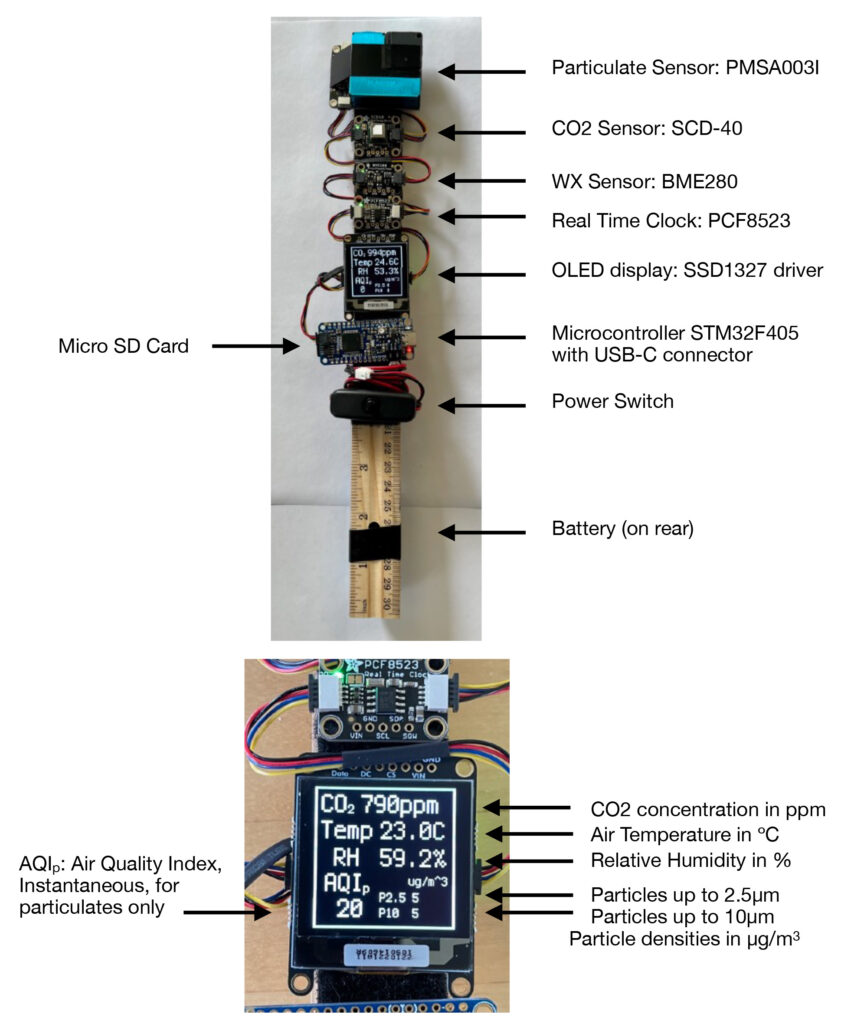STELLA-AQ, a DIY handheld air quality instrument created by Paul Mirel and developed with Dr. Nyssa Rayne – Outreach and Communications Coordinator for the Terra mission. It is an innovative educational tool that combines carbon dioxide (CO2) and particulate matter (PM) monitoring capabilities in a user-friendly device, requiring no soldering and offering a free build guide, open-source code, and a supportive community forum.
Built on the same platform as STELLA-Q, it allows users to interchange sensors and potentially create other instruments showcasing the STELLA platform’s modularity.
Build Your Own STELLA-AQ
STELLA-AQ Layout
Landsat satellite data has been extensively used to estimate air quality, particularly the concentration of particulate matter (PM) such as PM10 and PM2.5 in various urban areas. Here’s a summary of how Landsat data has been applied across multiple studies:
- Estimation of PM10 Concentration: Studies like Saraswat et al. (2017) utilized Landsat 8 OLI satellite data over Delhi, India, correlating atmospheric reflectance with PM10 measurements from ground stations. The research developed a multispectral empirical model, demonstrating a high degree of accuracy in predicting PM10 concentrations.
- Aerosol Optical Depth (AOD) Estimation: Li et al. (2019) compared AOD retrieved from Landsat-8 and Sentinel-2A data with ground-based Aerosol Robotic Network (AERONET) data across Chinese cities. They found strong agreement, indicating the effectiveness of these satellite data in urban AOD estimation.
- Aerosol Level Retrieval and PM2.5 Estimation: Rahman & Haque (2022) applied Landsat imagery to retrieve Aerosol Optical Depth (AOD) and estimate PM2.5 concentrations in the Dhaka Metropolitan Area. Their study demonstrated a significant increase in PM2.5 concentrations over time and highlighted correlations between AOD, Land Surface Temperature (LST), and NDVI.
- Spectral Response Experiment for PM2.5: Yang (2020) conducted a study in Fuzhou, China, using Landsat 8 OLI data to explore the sensitivity of spectral wavelengths to PM2.5 concentrations. They found that near-infrared reflectance and difference vegetation index (DVI) showed high correlation with PM2.5, developing a model effectively predicting PM2.5 concentrations.
- BR-PMx Models for PMx Concentration Estimation: Zhang et al. (2019) employed Landsat 8 OLI data and multilayer perceptron neural networks to estimate PMx (PM10 and PM2.5) concentrations in Beijing, China. Their models achieved satisfactory performance in estimating PMx concentrations, providing a promising method for assessing air quality in various cities.
- PM10 Estimation Using Landsat Data: Fernández-Pacheco et al. (2018) utilized Landsat 5 TM and Landsat 8 OLI data to estimate PM10 distribution in the Principado de Asturias, Spain. Their study established a relationship between path radiance and PM10 measurements using the Random Forest algorithm, generating efficient PM10 maps for local and regional studies.
- PM10 Mapping with Landsat TM Data: Saleh et al. (2007) developed an algorithm based on Landsat TM data to estimate PM10 concentrations over Penang Island, Malaysia. Their research illustrated a positive correlation between PM10 data and atmospheric reflectance in visible bands, providing insight into pollution concentrations in specific areas.
- Long-Term PM10 Estimation and Urbanization Impact: Shaheen et al. (2017) employed Landsat TM and ETM+ data to estimate PM10 concentrations over Gaza Strip, Palestine. They developed a multispectral algorithm showing a strong correlation between calculated and measured PM10, highlighting an increase in PM10 concentrations over urban areas due to urbanization
These studies collectively showcase Landsat’s versatility in estimating various particulate matter concentrations, validating its efficacy in assessing air quality and pollution levels across different regions and timeframes.
* Any use of trade, firm, or product names is for descriptive purposes only and does not imply endorsement by the U.S. Government.





